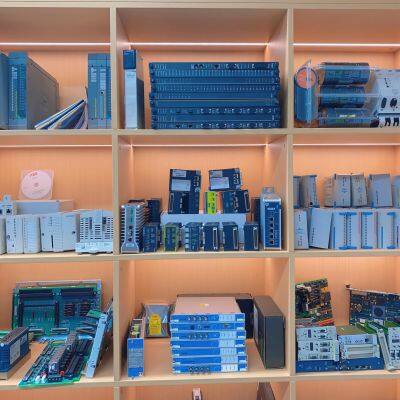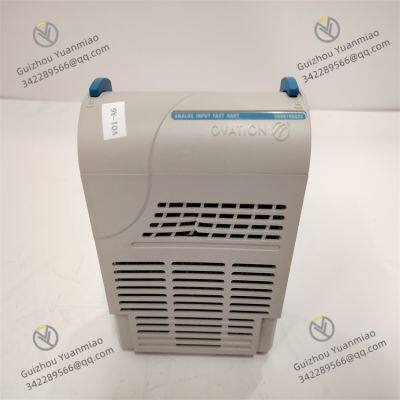Produktbeschreibung
I. übersicht
EMERSON 5X00106G02 ist ein wichtiges Ger?t, das weit verbreitet im Bereich der industriellen Automatisierung eingesetzt wird. In Bezug auf den Produkttyp kann es als hochleistungsf?higes Analog-Eingabemodul dienen und ist ein Mitglied der Ovation-Steuerungssystemfamilie. Es ist so konzipiert, dass es genaue und zuverl?ssige Messungen und Datenübertragungen für Analogsignale verschiedener industrieller Anlagen vor Ort bereitstellt, wodurch es zum effizienten und stabilen Betrieb von industriellen Automatisierungssystemen beitr?gt. Mit dem beschleunigten Prozess der industriellen Automatisierung, als Schlüsselbrücke zwischen Anlagen vor Ort und Steuerungssystemen, wirkt sich die Leistung des Analog-Eingabemoduls direkt auf die Steuergenauigkeit und den Betriebsstabilit?t des gesamten Systems aus. Aufbauend auf Emersons tiefgreifender technischer Akkumulation und Markenreputation im industriellen Bereich übernimmt das 5X00106G02 die Verantwortung, die pr?zise Erfassung und übertragung von Analogsignalen in komplexen industriellen Szenarien zu gew?hrleisten.

II. Technische Parameter
Anschluss- und Signalspezifikationen: Es verfügt über 16 Analog-Eing?nge, die mit HART (Highway Addressable Remote Transducer) kompatibel sind. Diese Kompatibilit?t erm?glicht es dem Modul, nicht nur Standard-Analogsignale zu sammeln, sondern auch mit intelligenten Anlagen vor Ort, die das HART-Protokoll unterstützen, zu kommunizieren und mehr Ger?testatus-, Diagnoseinformationen usw. zu erhalten, was die Ger?teverwaltungsfunktionen erheblich erweitert. Der Eingangssignalbereich ist sehr breit und kann Stromsignale von -40mA bis +40mA empfangen. Dieser breite Bereich kann verschiedenen Typen und Bereichen von Sensoren und Anlagen vor Ort angepasst werden und kann sowohl schwache Signale niedriger Stufe als auch Signale relativ hoher Amplitude genau erfassen.
Genauigkeit und Aufl?sung: Die Messgenauigkeit kann bis auf ±0,1% des vollen Skalenbereichs erreichen. In der industriellen Steuerung spielt die hochpr?zise Analogaufnahme eine entscheidende Rolle bei der Gew?hrleistung der pr?zisen Steuerung des Produktionsprozesses und der Stabilit?t der Produktqualit?t. Beispielsweise kann in der chemischen Produktion die hochpr?zise Messung von Analogparametern wie Temperatur und Druck im Reaktor den Reaktionsprozess genau regulieren und Qualit?tsschwankungen des Produkts oder sogar Produktionsunf?lle aufgrund von Parametervariationen vermeiden. Die Aufl?sung erreicht 16 Bit, was bedeutet, dass das Modul das Eingangssignal detaillierter quantisieren kann, extrem subtile ?nderungen im Signal erfassen kann und dem Steuerungssystem reichhaltigere und genauere Daten liefern kann, um so raffiniertere Steuerstrategien zu realisieren.
Weitere Leistungsindikatoren: Es hat niedrige Rauschmerkmale, mit einem Rauschpegel von <0.1μV p-p. In complex industrial electromagnetic environments, the low-noise design can effectively reduce the impact of external interference on signal acquisition, ensuring that the collected analog signals are true and reliable. The response time is <250ms. For industrial automation systems with high real-time requirements, a fast response enables the control system to make decisions and adjustments in a timely manner according to changes in on-site signals, ensuring the continuity and stability of the production process. In terms of power consumption, it operates under a 24VDC power supply with a power consumption of 20W, maintaining a relatively reasonable energy consumption level while meeting high-performance operation requirements. The operating temperature range is -40℃ to +70℃, and the relative humidity is allowed to be in the range of 0% to 95% (no condensation). This enables it to adapt to various harsh industrial environments from extreme cold to extreme heat, and from dry to humid, and can operate stably whether in oil extraction facilities in polar regions or chemical plants in tropical regions. The product dimensions are 19" x 8.5" x 6.3", and the weight is approximately 10 lbs. It adopts a rack-mounted design, which is convenient for integration into industrial control cabinets and other equipment, providing convenience for space layout and equipment installation in industrial sites.

III. Functional Features
High-Precision Analog Acquisition: Relying on advanced hardware circuit design and signal processing algorithms, 5X00106G02 can perform extremely accurate acquisition and digital conversion of analog signals. In practical industrial applications, such as the monitoring of analog quantities such as voltage and current in power systems, high-precision acquisition can ensure accurate mastery of the operation status of the power grid, timely detect potential fault hazards, and ensure the stable and reliable power supply.
HART Protocol Communication Expansion: HART protocol compatibility endows the module with additional communication and equipment management capabilities. Through this protocol, the module can communicate bidirectionally with intelligent on-site equipment, not only obtaining the measured values of the equipment but also reading the configuration information, operating status diagnostic data, etc. of the equipment. In petrochemical production, for intelligent pressure transmitters, temperature sensors and other equipment, remote parameter adjustment, equipment fault early warning and other functions can be realized with the help of HART communication, improving equipment maintenance efficiency and reducing maintenance costs.
High-Reliability Design: As a well-known brand in the industry, Emerson uses industrial-grade high-quality components in the design and manufacturing process of 5X00106G02, and has undergone strict quality inspection and reliability verification. When facing harsh conditions such as complex electromagnetic interference, mechanical vibration, and temperature shock in industrial sites, the module can operate stably, effectively avoiding data acquisition errors or system shutdown caused by hardware failures, and providing a solid guarantee for the reliable operation of industrial automation systems.
Convenient System Integration: The module adopts a standard rack-mounted installation method, and its size specifications comply with the general standards of industrial control cabinets, facilitating integration into industrial automation systems. At the same time, its communication interfaces and protocols follow industry general specifications, and can seamlessly interface with other components of the Emerson Ovation control system and third-party control systems, which greatly improves the convenience and flexibility of system construction and reduces the difficulty and cost of system integration.

IV. Common Faults and Solutions
Abnormal Signal Acquisition
Fault Phenomenon: The analog signal collected by the module has a large deviation from the actual value, or the signal is unstable such as fluctuation and jump.
Possible Causes: Sensor failure, resulting in inaccurate output analog signals; damage or poor contact of the cable connecting the sensor and the module, causing attenuation and interference during signal transmission; hardware failure of the module, such as damage to the analog input channel, failure of the signal conditioning circuit, etc.
Solutions: First, check the working status of the sensor. A standard signal source can be used to calibrate and test the sensor. If the sensor is faulty, replace it with a new one in time. Carefully inspect the connecting cable for damage, bending, loose joints, etc., and repair or replace the problematic cable. If the cable is normal, try connecting the sensor to other spare channels of the module for testing. If the signal collected in the spare channel is normal, it may be a hardware failure of the original channel, and it is necessary to contact professional maintenance personnel to repair the module or replace the faulty channel.
Communication Fault
Fault Phenomenon: The module cannot communicate normally with the control system, data transmission is interrupted, or packet loss and errors occur during communication.
Possible Causes: Communication cable failure, such as damage or poor contact of network cables, serial cables; incorrect configuration of communication protocols, inconsistent communication parameter settings between the module and the control system; hardware failure of the module's communication interface.
Solutions: Check the connection of the communication cable, re-plug the cable to ensure a firm connection. Use cable testing tools to detect the connectivity and signal transmission quality of the cable, and replace the cable in time if there is a problem. Carefully check the communication protocol parameters of the module and the control system, including baud rate, data bits, stop bits, parity bits, etc., to ensure that the parameters of both parties are consistent. If the parameter settings are correct, the replacement method can be adopted. Use a normal communication interface device to replace the communication interface of the module for testing. If the communication is normal after replacement, it indicates that the original communication interface has a hardware failure, and the communication interface module needs to be repaired or replaced.
Module Overheating Fault
Fault Phenomenon: The module has an excessively high temperature during operation, and even an overheating alarm occurs, affecting the normal performance and stability of the module.
Possible Causes: The temperature of the working environment where the module is located is too high, exceeding its normal working temperature range; the heat dissipation conditions of the module are poor, such as failure of the cooling fan, severe dust accumulation on the heat sink, etc., resulting in ineffective heat dissipation; the module is in a high-load working state for a long time, with excessive internal power consumption and excessive heat generation.
Solutions: Check the working environment of the module, improve ventilation and heat dissipation conditions, and install air conditioners, exhaust fans and other equipment to reduce the ambient temperature. Clean the dust on the module's heat sink, check whether the cooling fan is operating normally, and repair or replace the cooling fan in time if there is a failure. Evaluate the working load of the module. If the load is too high due to too many connected devices, consider increasing the number of modules for load sharing, or optimize the system configuration to reduce unn?tige Datenakquisitionstasks und die Arbeitslast des Moduls reduzieren.


Honeywell 51454926-176 Sicherheitssteuermodul
WOODWARD BUM60-1224-54-B-001-VC-A0-0093-0013-G003-000 Controller
GE VPROH2B IS215VPROH2BC Notfall-Turbinschutzkarte
GE DS2020PDMAG6 Stromverteilungsmodul
GE IS200AEPCH1ABC Crucial Leiterplatte
GE IS210MACCH2AEG Leiterplatte
GE IS210MACCH1AGG Einachsiges Bewegungssteuerungsmodul
GE IS210MACCH2AGG Analog Output Modul
GE IS200AEPCH1BAA Leiterplatte
GE IS200AEPAH1ACB Leiterplatte
GE IS210BPPBH2BMD Leiterplatte
GE IS200AEPAH1AFD Leiterplatte
 yezi
Hallo! Willkommen in meinem Shop. Lass es mich wissen, wenn du Fragen hast.
yezi
Hallo! Willkommen in meinem Shop. Lass es mich wissen, wenn du Fragen hast.





